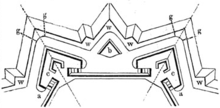

A place-of-arms (Italian: piazza d'armi, French: place d'armes) is any place in a fortification where troops can gather. The term has a number of meanings, but it generally refers to an enlarged area of the covertway designed as an assembly point for soldiers, or a square in the centre of a fortress, also known as a parade ground.[1]
There are two types of places-of-arms:[2]
- Salient place-of-arms: a place-of-arms which protrudes outside the polygonal shape of the fortification
- Re-entrant place-of-arms: a place-of-arms which does not protrude outside the polygonal shape of the fortification
References
[edit]- ^ James, Charles (1802). A New and Enlarged Military Dictionary. London: T. Egerton. p. 629.
- ^ Spiteri, Stephen C. (2010). "Illustrated Glossary of Terms used in Military Architecture". ARX Supplement. MilitaryArchitecture.com: 646. Archived from the original on 3 June 2017. Retrieved 5 December 2012.
Well, that’s interesting to know that Psilotum nudum are known as whisk ferns. Psilotum nudum is the commoner species of the two. While the P. flaccidum is a rare species and is found in the tropical islands. Both the species are usually epiphytic in habit and grow upon tree ferns. These species may also be terrestrial and grow in humus or in the crevices of the rocks.
View the detailed Guide of Psilotum nudum: Detailed Study Of Psilotum Nudum (Whisk Fern), Classification, Anatomy, Reproduction